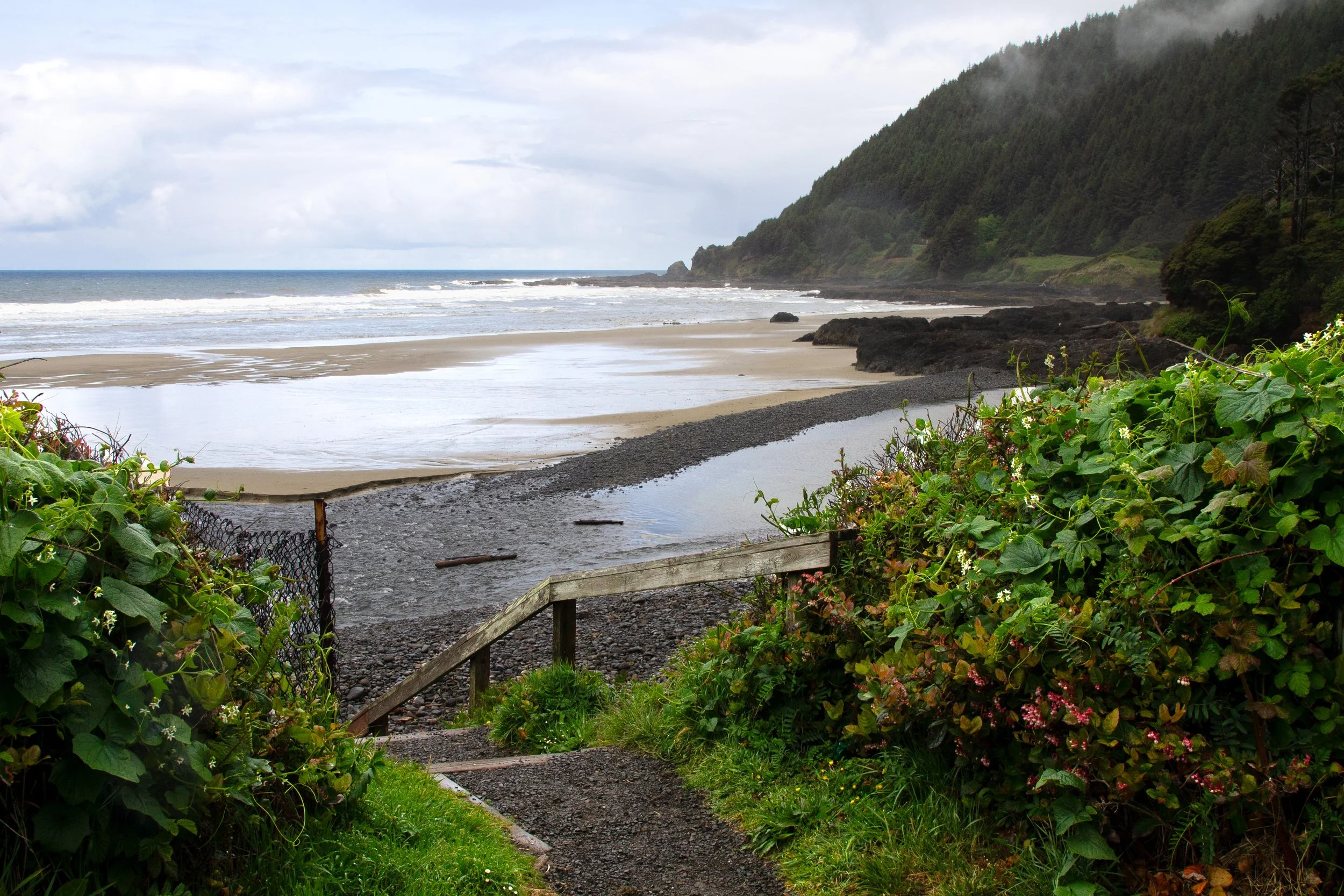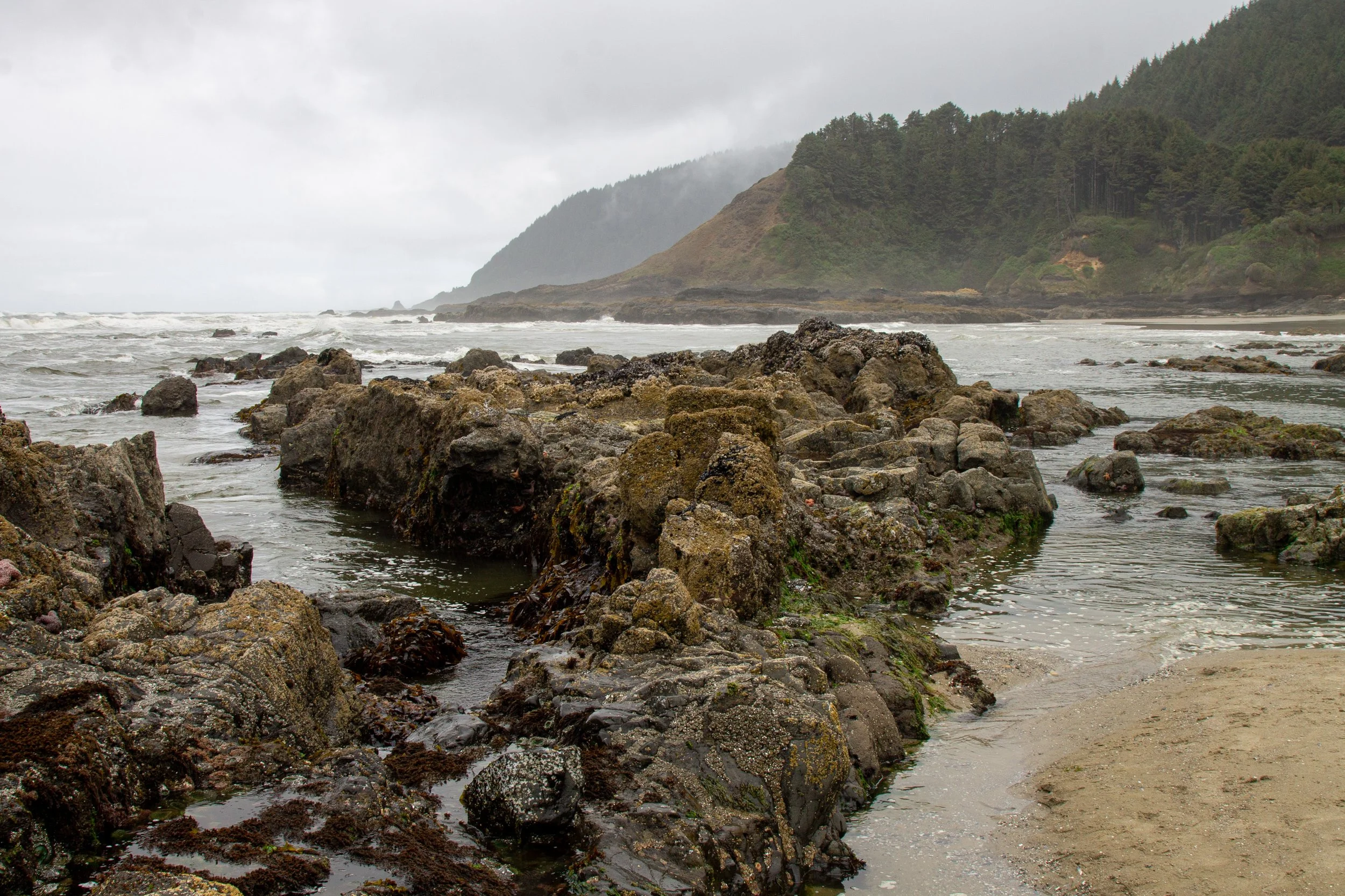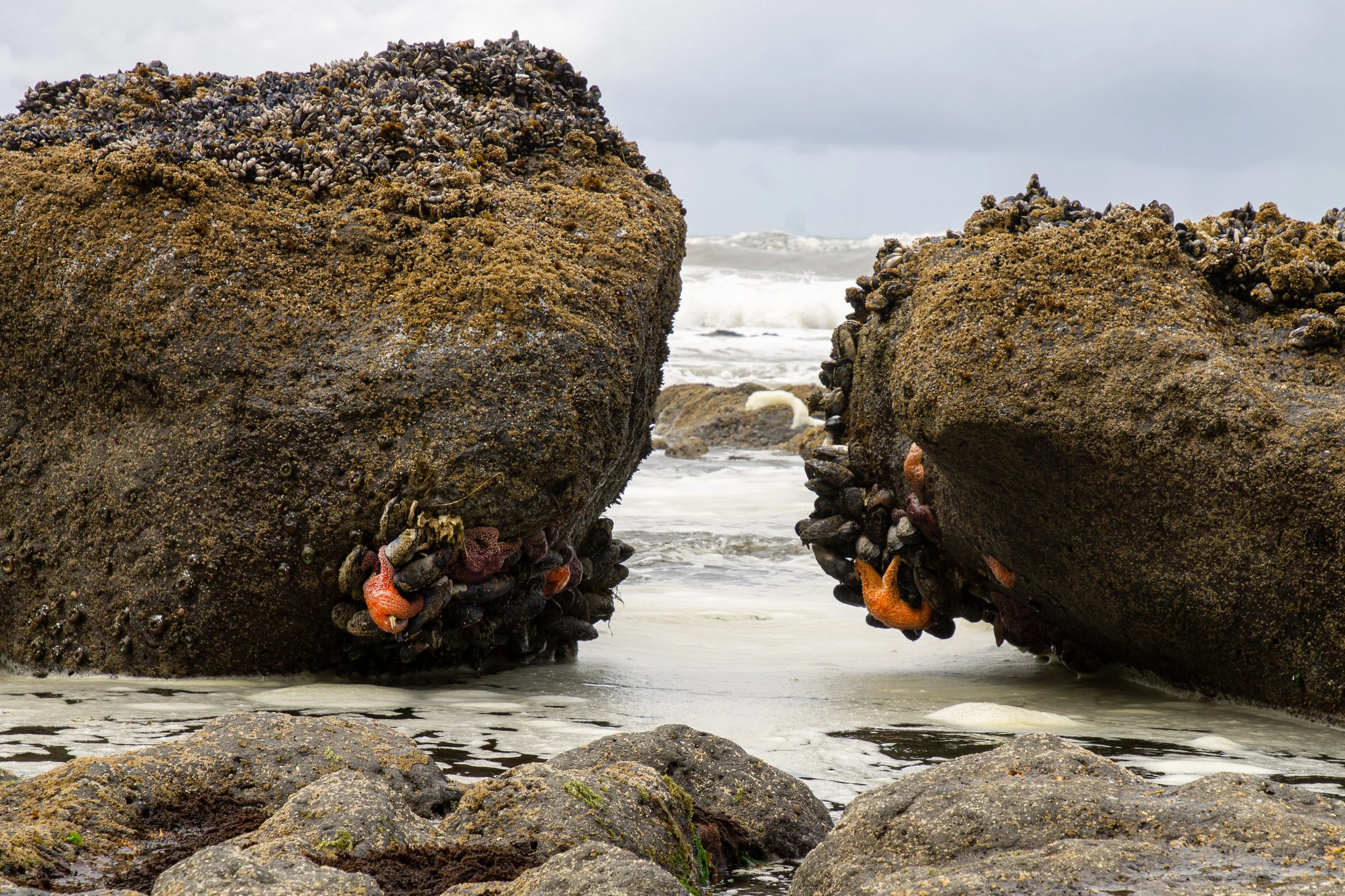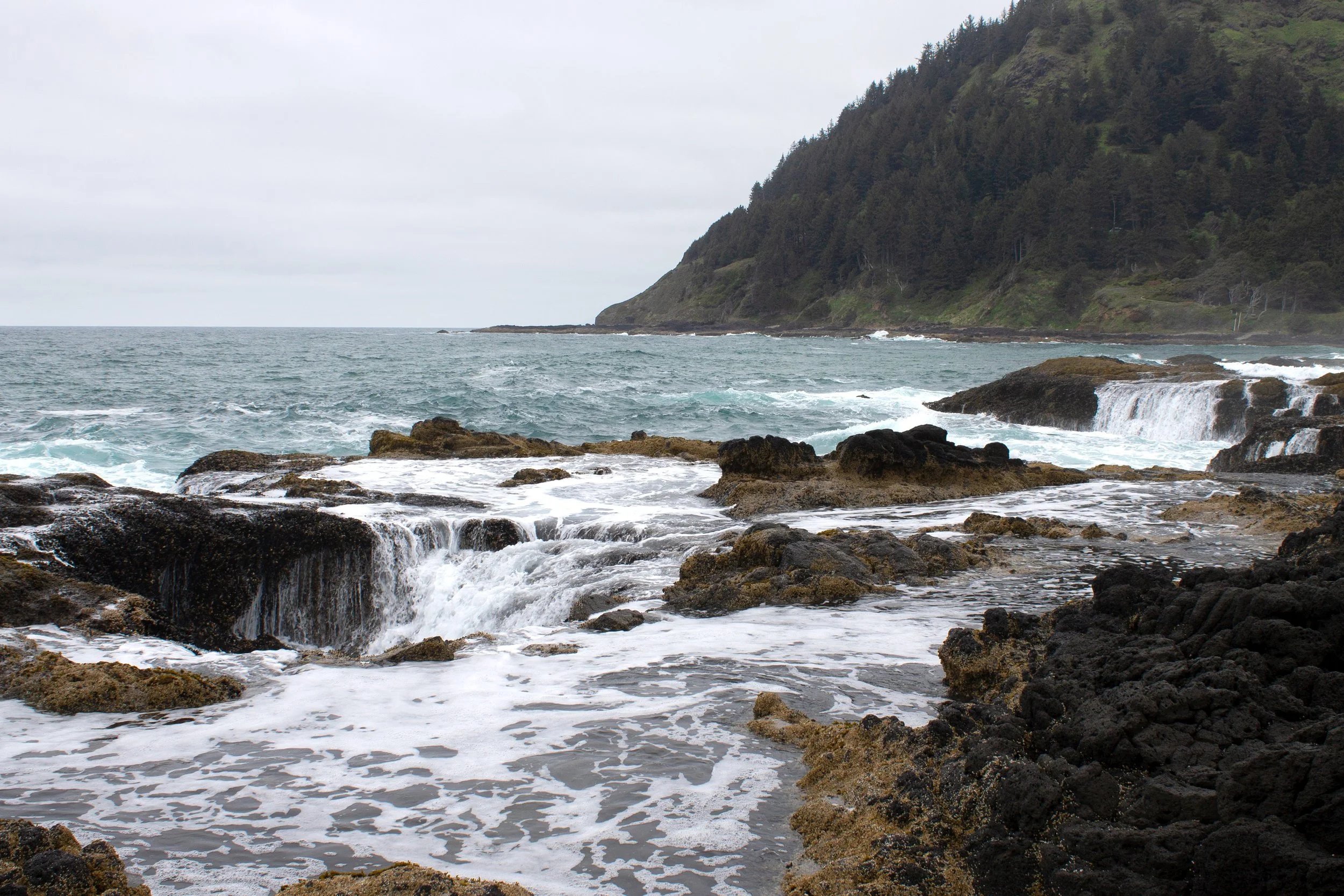Neptune State Scenic Viewpoint
Neptune State Scenic Viewpoint has the most misleading name on the Oregon Coast. It sounds like a quick roadside stop. In reality, you could spend a whole day exploring the four separate beaches that make up the two-mile-long park. Only a few minutes south of the incredibly popular Cape Perpetua, it gets a fraction of the visitors despite having similar scenery. Expect towering headlands and a craggy basalt shoreline with excellent tidepools. As the tide recedes, look for agates, jasper, and sea glass on the sand. Here is everything you need to know about visiting Neptune State Scenic Viewpoint.
Bob Creek
The four stops
Neptune State Scenic Viewpoint has four access points over two miles, with one about every half mile. Because of the rockiness of the coastline, there isn’t an easy way of walking between them. You’ll want to move the car to visit more than one. These are the stops:
Neptune Beach North
Neptune Beach South
Strawberry Hill Wayside
Bob Creek
It’s hard to pick a favorite. They all have incredible scenery and cool rock formations. Neptune South, Strawberry Hill, and Bob Creek are the best for rock-hounding. Strawberry Hill often has harbor seals lounging on the rocks. Neptune North has the weirdest anemones but wow the competition for that category is high. All of Neptune State Scenic Viewpoint is great for seeing intertidal life.
Tidepools at Neptune Beach South
Know before you go
It’s free to visit Neptune State Scenic Viewpoint. You don’t need a pass to park in any of the lots.
The four stops are on the obscure side in terms of the Oregon Coast, but the parking lots are small. They fill up sometimes on summer weekends, especially Strawberry Hill and Bob Creek.
Dogs are welcome at Neptune State Scenic Viewpoint.
Neptune Beach South has vault toilets and picnic tables. Bob Creek has a picnic area.
Low tide is my favorite time to visit. All the stops have excellent tidepools. Stay on sand or bare rock to avoid crushing any critters while you explore.
Neptune State Scenic Viewpoint is a popular rock-hounding spot. Searching for rocks on the beach is fine, but don’t dig in the cliffs. They contain shell middens that are protected by law.
Neptune North
Neptune Beach North
Neptune Beach North is only a few minutes south of Cape Perpetua. It’s easy to drive past without noticing if you aren’t looking for it. A discreet sign points towards a small parking area next to Highway 101. Once you park and start on the path to the beach, the grandeur of the scenery becomes clear. Like Cape Perpetua, basalt forms the tall headlands and broad rocky shores at Neptune Beach. This erosion-resistant rock comes from local volcanic activity around 50 million years ago. Like the rest of Neptune State Scenic Viewpoint, the bluffs along the coast are mostly sandstone, which adds tans and oranges to the otherwise dark color palette of the rocks.
It’s easiest to explore Neptune Beach at low tide
The rocks on shore look stranger once you get up close. Some are furry with seaweed. Others are spiky with barnacles. Low tide at Neptune Beach is magical. In a land of bizarre tidepool animals, the anemones at Neptune Beach North stand out. They’re so saggy. Giant green anemones hang from rough stone looking like droopy wallpaper. Barnacles, sea stars, mussels, and limpets also thrive here. To find the best tidepool life, head right once you’re on the beach. Climb onto the rocks at the north end of the beach. A deep crack is filled with intertidal animals. Nearby is a big rock arch you can walk under.
Giant green anemones and sea stars at Neptune North
At high tide, waves cover the sand, striking the cobbles near shore and splashing up onto the chunks of basalt. During very high tides and winter storms, I’d stay off the beach. Admire the waves from above from the viewpoint near the parking lot.
Neptune South
Stairs to Cummins Creek and Neptune Beach South
A half mile away from Neptune North, the entrance to Neptune Beach South is just as unassuming. This stop has the most amenities in Neptune State Scenic Viewpoint, including vault toilets and a picnic area overlooking the ocean. Lupines grow in the grass on top of the bluff in spring. A short staircase leads down to the beach.
The south end of the beach has the best tidepools
At the bottom of the stairs, Cummins Creek flows out across the beach into the ocean. Looking inland, you’ll see the picturesque arch of the Cummins Creek Bridge. The creek is a good place to search for agates but can get a little picked over because of its popularity as a rock-hounding spot.
Look for sea stars, mussels, and barnacles at low tide
Once again, the tidepools are the biggest draw for me. This time head to the south end of the beach. The rock formations there have many pools filled with anemones, algae, hermit crabs, sculpins, and sea stars. Barnacles, mussels, and anemones cling to rock walls and boulders. Be careful not to crush anything as you explore. As you get farther out, it can be hard to find a patch of bare rock to step on. As always, keep your eye on the tide and watch for unexpected waves. It’s generally okay to gently touch animals in tidepools. Just avoid the center of anemones, their digestive tracts. When in doubt, leave it be.
Strawberry Hill
Wild strawberries bloom at Strawberry Hill Wayside in spring
While far from being one of the Oregon Coast’s most famous places, Strawberry Hill gets more visitors than either of the Neptune beaches. On summer weekends, it might be hard to find a parking spot in what is more of a roadside pullout than a lot. It has no amenities. Once you park, take the steep dirt trail down the coastal bluff. On the way down, look straight out toward the ocean. Harbor seals like to hang out on the rocks that are farthest out in the water.
Harbor seals at Strawberry Hill
In late spring and early summer, you might see seal pups. Admire them from a distance, at least 150 feet, and back away if they seem nervous about you (putting their heads up when you approach, diving into the water, etc). You’ll notice the ones in the first picture looking alert. A woman was approaching them, getting much closer than the rest of the visitors. I was farther back but still moved away, annoyed with her for not doing the same. Please don’t be that tourist. Harbor seal pups often stay on shore for safety while their mothers hunt. Orcas come to the Oregon Coast to hunt seal pups in the spring.
When seals lie there like blobs, you’re far enough away
Strawberry Hill has a reputation for great tidepools. You can find plenty of critters here, but I think they’re less plentiful and harder to reach than the other stops in Neptune State Scenic Viewpoint. The rocks are steep and can get very slippery. If you’re willing to do some climbing, you can find anemones, sea stars, mussels, and barnacles.
Sea stars at Strawberry Hill
If you head either north or south of the central rock formation at Strawberry Hill, you can find some sand, at least at low tide. Since the beaches here are harder to reach than the others at Neptune State Scenic Viewpoint, the rocks aren’t so heavily searched. Look for agates, jaspers, and petrified wood. A receding tide is the best time to look, especially in the winter. Avoid the beach during high tides and winter storms.
The rocky beach at Strawberry Hill
Bob Creek
The picnic area at Bob Creek has unbeatable views
Bob Creek is the southernmost stop at Neptune State Scenic Viewpoint. It has all the majesty of the previous beaches, with dramatic basalt headlands and platforms. A small picnic area in a grassy field has spectacular views of the ocean. A few steps down will get you to the beach. To the right, you’ll see Bob Creek flowing into the Pacific. The creek is hard to cross without getting wet feet. It’s easier to head south. Like the other stops, it’s easiest to explore at low tide when you can walk on the sand. High tide brings the waves up to the cobbles, which clack as they roll.
Low tide at Bob Creek
Bob Creek has excellent tidepools. Unlike Strawberry Hill, they’re easy to reach when the tide recedes. Although by now I’m sure it’s clear that my main interest is intertidal critters, Bob Creek is best known as an agate hunting spot. Its reputation draws a lot of rock hunters, making it harder to be first to spot the agates, jaspers, fossils, sea glass, and petrified wood. When I visited, everyone on the beach was looking for rocks. I’ll read about geology all day, but I’m not interested in collecting. I searched a little to see if it lived up to its reputation and found a couple of small agates without much trouble. I’d suggest searching farther south on the beach, which tends to get less picked over. If you visit when the tide is very low, you can find a larger-than-average sea cave on the south end of the beach.
Beach at Bob Creek
Like the other stops in Neptune State Scenic Viewpoint, Bob Creek has a layer of shell middens in the bluffs. They’re protected by law. Don’t dig in the cliffs or disturb them. If you’re just looking, they’re a fascinating window into the past. The middens are a whitish layer toward the top of the bluffs just under the vegetation. They’re made of discarded material, especially shells, left by coastal tribes hundreds to thousands of years ago. They make it tempting to picture people long ago watching the ocean with an enjoyment that transcends time and culture.
Shell midden at Neptune South
Hiking trails
Cummins Creek Trail
If you can stand to leave the ocean, Neptune State Scenic Viewpoint is close to inland hiking trails that explore an old-growth coastal forest. Across from Neptune Beach South is a short road that leads to the Cummins Creek Trailhead. From here, a trail follows Cummins Creek through a forest of ferns, Doug firs, and Sitka spruce. This trail isn’t so much about reaching a destination as enjoying the peace of the forest. The Cummins Creek Trail connects to other trails. To get a feel for the woods without committing a lot of distance, you could walk an easy half mile until the fork in the trail and then turn around. For a longer hike, check out the 6-mile Cummins Creek Loop.
Getting there
Neptune State Scenic Viewpoint is a few minutes south of Cape Perpetua on Highway 101. Look for all four entrances on the right side of the highway about a half mile from each other. You can reach any of the parking areas in a low-clearance vehicle. The drive from Portland takes about 3 hours.
Explore nearby
See the geologic wonders of Cape Perpetua.
Find the best things to do in Yachats.
Drive south to visit Heceta Head Lighthouse.
Find the best tidepools on the Oregon Coast.
























